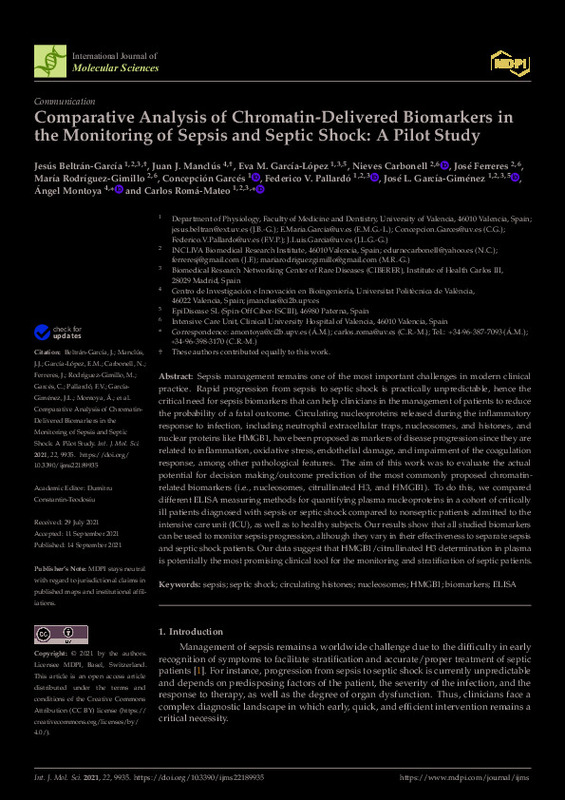JavaScript is disabled for your browser. Some features of this site may not work without it.
Buscar en RiuNet
Listar
Mi cuenta
Estadísticas
Ayuda RiuNet
Admin. UPV
Desde el lunes 3 y hasta el jueves 20 de marzo, RiuNet funcionará en modo de solo lectura a causa de su actualización a una nueva versión.
Comparative Analysis of Chromatin-Delivered Biomarkers in the Monitoring of Sepsis and Septic Shock: A Pilot Study
Mostrar el registro completo del ítem
Beltrán-García, J.; Manclus Ciscar, JJ.; García-López, EM.; Carbonell, N.; Ferreres, J.; Rodríguez-Gimillo, M.; Garcés, C.... (2021). Comparative Analysis of Chromatin-Delivered Biomarkers in the Monitoring of Sepsis and Septic Shock: A Pilot Study. International Journal of Molecular Sciences. 22(18):1-15. https://doi.org/10.3390/ijms22189935
Por favor, use este identificador para citar o enlazar este ítem: http://hdl.handle.net/10251/196903
Ficheros en el ítem
Metadatos del ítem
| Título: | Comparative Analysis of Chromatin-Delivered Biomarkers in the Monitoring of Sepsis and Septic Shock: A Pilot Study | |
| Autor: | Beltrán-García, Jesús García-López, Eva M. Carbonell, Nieves Ferreres, José Rodríguez-Gimillo, María Garcés, Concepción Pallardó, Federico V. García-Giménez, José L. Romá-Mateo, Carlos | |
| Fecha difusión: |
|
|
| Resumen: |
[EN] Sepsis management remains one of the most important challenges in modern clinical practice. Rapid progression from sepsis to septic shock is practically unpredictable, hence the critical need for sepsis biomarkers ...[+]
|
|
| Palabras clave: |
|
|
| Derechos de uso: | Reconocimiento (by) | |
| Fuente: |
|
|
| DOI: |
|
|
| Editorial: |
|
|
| Versión del editor: | https://doi.org/10.3390/ijms22189935 | |
| Código del Proyecto: |
...[+] |
|
| Agradecimientos: |
This activity received funding from the European Institute of Innovation and Technology (EIT). This body of the European Union receives support from the European Union's Horizon 2020 research and innovation program. C.R-M. ...[+]
|
|
| Tipo: |
|









